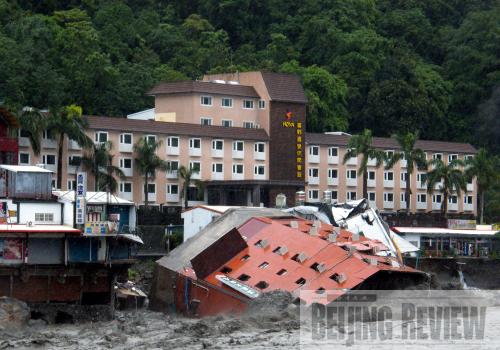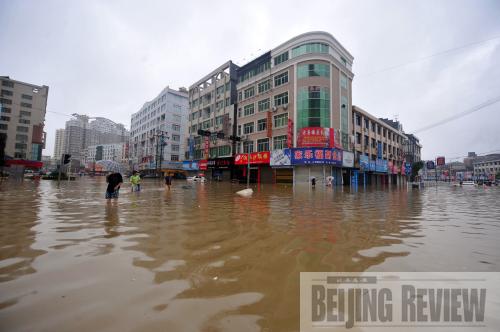|
 |
|
TOPPLED BY FLOODS: A six-story hotel in eastern Taiwan collapsed on August 9 after flooding triggered by Typhoon Morakot eroded its foundation (WU JINGTENG) |
Typhoon Morakot, which crashed into coastal Chinese provinces after causing havoc in Taiwan on August 8, has left eight people dead and three others missing on the Chinese mainland, according to the Ministry of Civil Affairs on August 11. Heavy rains that came with the eighth typhoon to hit the country this year have led to deadly floods, mudslides and landslides on both sides of the Taiwan Straits.
By 4 p.m. on August 11, the typhoon had affected 11 million people in five provinces and forced 1.57 million to evacuate. The ministry said 449,600 hectares of farmlands were water-inundated, with direct economic losses totaling 9.72 billion yuan ($1.4 billion).
Two people died and four were injured in an August 10 landslide in Zhejiang Province, which recorded unprecedented rainfall. The landslide toppled a four-story residential building in Pengxi, Taishun County, after five straight days of continuous rain. The meteorological station in Taishun recorded rainfall of 1,241 mm from August 6 to 10, representing the most rain observed by a single meteorological station in Zhejiang in six decades.
 |
|
WATERWORLD: Pedestrians wade through the flooded streets of Cangnan County, in east China's Zhejiang Province, after downpours brought by Typhoon Morakot (WANG DINGCHANG) |
According to a Xinhua News Agency report, Morakot, the worst typhoon to hit Taiwan in nearly five decades, killed at least 67 people and left 61 others missing on the island as of 12 p.m. on August 12. Another 45 people were injured after the typhoon hit much of the central-south part of the island. The casualty list included a crew of three onboard a helicopter that crashed during a disaster-relief mission in southern Pingdong.
Morakot weakened to become a tropical storm on August 10 and moved into the Pacific on the afternoon of August 11, but still caused heavy flooding and grave losses along its path through China.
Chinese Vice Premier Hui Liangyu, who headed to the typhoon-hit regions in Fujian and Zhejiang provinces, warned on August 11 that the country faces the grim task of fighting secondary disasters as a result of the typhoon.
Flooding is still likely as heavy rainfall persists in the south and many rivers continue to collect water, he said.
More than 20 rivers had water levels above the line that triggers flood alarms in Zhejiang, Fujian and Anhui provinces.
| 